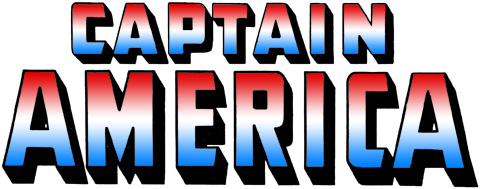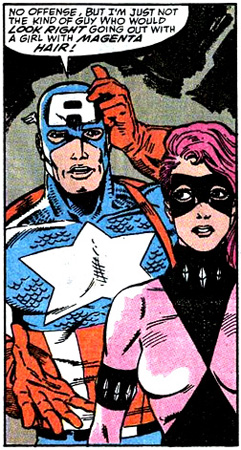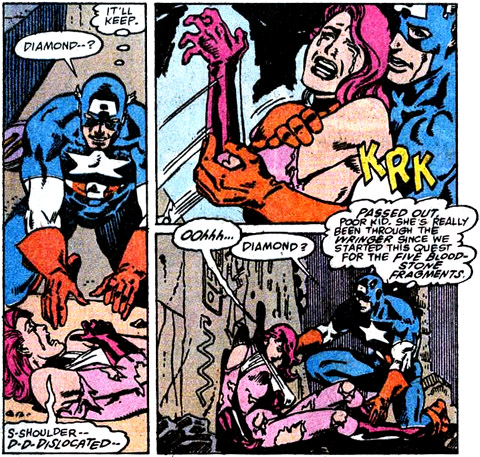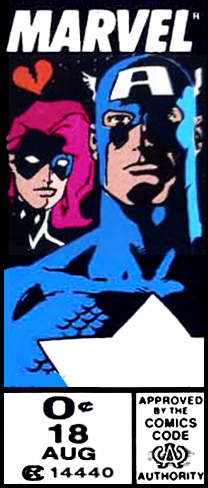
Joe Simon, Jack Kirby, Christopher Markus, Stephen McFeely, and Joe Johnston, 2011
The premise of Captain America is that a WWII-era super-soldier finds himself in the modern world after decades in suspended animation. Though he has no "superpowers" per se, he exudes an effortless authority that sees him acclaimed as de facto leader of the world's mainstream superheroes from the moment he returns. (Even Wolverine eventually comes around.) Yet just as Superman is set apart from the others because he comes from another world, Captain America is set apart from the others because he comes from another time.
Or at least, that's been the premise of Captain America for the past fifty years. It wasn't the premise of Captain America when he first debuted, because it was 1940 and WWII was in progress. Back then the premise of the character was a lot simpler: Steve Rogers, a weakling who wants to join the Army but keeps getting classified 4-F, volunteers to undergo an experimental procedure that turns him into a peak human athlete with unsurpassed fighting skill; much Nazi-punching ensues. That is to say, this business about Cap having been a super-soldier in WWII is not backstory the way "Wolverine fought in WWII" is. It's the actual beginning of the Captain America serial. This is important! I don't know why it's important, but it is. Like, in the late '80s, there was a subplot in Fantastic Four in which Crystal rejoined the team and Johnny found her presence distracting because he and Crystal had dated when they were teenagers. Somehow, the fact that I could dig through the back issue bins and find the Fantastic Four comics from the '60s in which Johnny and Crystal are teenagers and are dating made the personal history between them carry a lot more weight than if that history had only been established in flashbacks. And similarly, that Captain America would earn the deference of much more powerful superheroes somehow gains credibility from the extradiegetic fact that he's appeared in print for 73 years. So it makes sense to me that those behind the Marvel cinematic universe would want to start the Captain America franchise with a WWII movie. If we're supposed to buy him as a Golden Age figure transported to the present, starting off with two hours of a Golden Age war story helps a lot. It's just a shame that compared to the man-out-of-time version, the Golden Age Captain America is so dull.
When I say that he's dull, I mean narratively dull — "heroic, patriotic weakling becomes heroic, patriotic strong guy, does heroic, patriotic things" is not a very compelling premise. But a WWII setting would also seem to place a ceiling on the level of spectacle the movie could provide — which is why, in spite of the logic above, I was still pretty surprised that a studio would actually stake nine figures on a movie set half a century before the target audience was born. As it turned out, the filmmakers did try to jazz things up by throwing a Cosmic Cube into the mix, so the scenes of soldiers shooting at each other include some blue zaps flying back and forth along with the bullets. Otherwise, yeah, it's a pretty straightforward Cap-in-WWII story — a workmanlike adaptation of some pretty lackluster source material. I'll be interested to see what the sequels are like. After all, while the effectiveness of Captain America as a character was indeed enhanced, at least for me, by the existence of the Golden Age comics, that doesn't mean that I actually had any interest in reading them.
The cinematic Captain America has, of course, already appeared in the Avengers movie, so we've had a glimpse of how the franchise is going to handle Cap in his man-out-of-time role. There have been a few takes on the concept in the comics. The Marvel movies appear to be cribbing more from the Ultimate line than from the mainstream Marvel Universe, so I was afraid that we might be in for Mark Millar's "Cap is from the '40s, When Men Were Men™" schtick. Or, failing that, perhaps they'd use Brian Bendis's rendition of the character whose superpower is SHOUTING AT EVERYONE ALL THE TIME! As it turns out, they're going with kind of a "BYU quarterback" vibe, which isn't too far removed from the character I remember from the '80s and early '90s. The Cap of my youth was portrayed as somewhat older — theoretically in his sixties, but thanks to the super-soldier serum and the years in suspended animation, biologically in his mid-thirties — and was more broad-shouldered and commanding than the movie version. He was also the world's biggest square. He gave corny speeches, he religiously filled out the Avengers paperwork after each adventure, and at the end of a training session Jarvis would literally bring him a glass of milk. Then there were his ethics. He was scrupulously honest, both in word and deed. He regularly went to extraordinary lengths to save the lives of supervillains who had moments earlier been trying to kill him. More than that — the super-soldier who had spent years on the front lines in WWII made the following claim: "I believe that guns are for killing, and killing is the ultimate violation of individual rights — the ultimate denial of freedom. I never carry a gun. I have never taken another person's life." Back in those days Captain America's series was written by Mark Gruenwald, one of the first lifelong comic book fans to break into the industry as a creator, and much of his run was about exploring how a Scout Leader like Cap fit into an increasingly "grim and gritty" landscape where "heroes" like Wolverine and the Punisher were the ones developing a following. For instance, one of Gruenwald's big story arcs involved the government claiming ownership of the Captain America concept and replacing Steve Rogers with a roided-up right-winger who'd called himself the Super-Patriot. Disaster predictably ensued.
Cap's square persona played a big role in another of Gruenwald's storylines, which despite its dubious beginning ended up becoming my favorite: his unlikely relationship with Rachel Leighton. Why so unlikely, you ask? Well, for one thing:

I've heard it said that if you're a comics writer and you could swap a different character into the lead role of the story you're about to tell, then you should scrap that story. No worries here. What makes this story work is that if you were to ask who would be the least likely character to bring a girl with pink hair to the 1989 Avengers Christmas party, the answer would be Captain America. Yes, less likely than Jarvis. Not only was Cap the ultimate straight arrow, but the ultimate stiff as well. Here's a sampling of his track record with women in the late '80s:
Attractive single mom, whose son Cap had helped out, takes Cap's hand and says, "I can't tell you how much it's meant to him… and me. If there's ever anything — anything at all — that I can do for you—"
Cap's response: "My responsibility to the youth of America is not one I take lightly."
Another attractive young woman hoping for a date: "When's the last time you relaxed and forgot your responsibilities for a couple hours?"
Cap's response: "I manage to schedule in some leisure time during the week — read, swim, work out…"
Attractive sorceress does a spell for Cap, asks him to dinner in return, runs her foot up his leg
Cap's response: (thought bubble) "Ulp! If I ever get out of this with my dignity intact, I'll never ask her to do me a favor again!"
And yet, for a while there, Cap — while otherwise acting exactly the same — broadened his horizons enough to share smooches with a small-time supervillain who spent most of her ill-gotten gains at Manic Panic. Her code name was Diamondback.
Diamondback was a member of the Serpent Society, a group of snake-themed baddies who were frequent antagonists of Cap's during Gruenwald's run. Some members, such as the Cobra and Sidewinder, were established Marvel villains, but in the Society's first appearance we meet a number of new ones, Diamondback among them. Diamondback has no powers — she's just a costumed athlete who throws "diamonds" with gimmicks like Hawkeye's trick arrows: exploding diamond, poison-tipped diamond, etc. She's also what 1980s Marvel comics called "a sleaze." She has the aforementioned pink hair and is sassy, and as Cap's sometime partner Nomad puts it, "reeks of availability." In her first two encounters with Cap she thinks she can nail him with a kill shot — and both times she demurs: "Do I really want to do this to such a hunk—?" But however hot Diamondback may be for Cap, however much she thinks to herself that she would "do anything for a heavy date with him — even go straight!", she is totally barking up the wrong tree. In Captain America #319 Cap catches her on an assignment, and it turns out they're both hunting down the same vigilante — Cap because the vigilante is a killer, and Diamondback because he's been killing supervillains in particular — and they team up. She takes him to her airship: "Buckle up, Captain. Don't worry — I'm a great pilot. In fact, I do everything great, in case you haven't noticed!" But then, once they're a few thousand feet up — remember, I did say the beginning was dubious — Rachel grabs the key, drops it down the neck of her costume, and tells Cap that he'd better come get it before the ship crashes. Cap replies, "No deal. I don't believe you're willing to throw away your life on something so fleeting as a few moments of pleasure," and prepares to bail out. Rachel apologizes — "I'm sorry my desire for you made me act so foolish. It won't happen again, I promise you. Look, if you agree to work with me on this, I promise I'll not only keep my hands to myself, I'll even tell you where Serpent Headquarters is!" But Cap says she's proven herself untrustworthy, and Rachel has to do a lot of fast talking just to keep him from grabbing a parachute and bailing out.
Diamondback then disappears for two years, real time. She re-emerges when a nasty piece of work called the Viper pulls off a hostile takeover of the Society, and she calls Cap for help. Cap is now working with several sidekicks — the Falcon, Nomad, D-Man — and Diamondback flirts with them as is her wont… but with Cap she is serious and respectful, her earlier hots for him having grown into unrequited love:

A year later, real time, Rachel teams up with Cap for a third time in a story called "The Bloodstone Hunt," and even though the title of the magazine was still Captain America, it is more Rachel's story than Cap's — which the corner box changed to acknowledge, as you can see over to the side there. (Yes, that's real!) In "The Bloodstone Hunt," a bunch of different villains are after a set of mystical gems. Diamondback joins the hunt on behalf of the Serpent Society, but runs afoul of Baron Zemo and his crew, who knock her out, put her in a coffin and dump her into a near-bottomless pit. But she'd given Cap an emergency alert receiver during their last team-up, and he comes to her rescue. Together, they face off against Zemo, Batroc, Machete, Zaran the Weapons Master, some murderous Incas, some killer sharks, a pit full of snakes, a living mummy… run-of-the-mill stuff for Cap, who tackles it all nonchalantly and makes it through with barely a scratch. But Diamondback isn't Captain America. She's just a kid from a bad neighborhood who fell into her older brother's gang and, this being the Marvel Universe, ended up taking on a gimmick and a costume as she became a career criminal. So when she goes on this adventure with Cap, she gets injured. A lot. Hawkeye gets injured a lot too in his new series, but to a great extent that's played for laughs. Mark Gruenwald doesn't play Diamondback's injuries for laughs. When she gets hurt, she cries:

And yet she doesn't give up — she's too determined to redeem herself and prove herself worthy at least of Cap's attention, if not his affection. I don't know about you, but I found it impossible not to love her. And it occurs to me that, in this at least, Rachel Leighton is not at all dissimilar to the "weakling who never gives up" Steve Rogers we meet at the beginning of the Cap movie, whom I dismissed as dull. Maybe the pink hair makes it less hokey.
(Postscript: At the end of the bloodstone hunt, Rachel gets knocked out and kidnapped by Crossbones — it's the first appearance of someone who would become one of Cap's most dangerous enemies. Bruised, bloodied, her costume in tatters, she's gagged and handcuffed to a bed in a brothel in the foreign hellhole of Lowtown Madripoor. So how does Cap rescue her this time? He doesn't. He gets waylaid by Crossbones. And in a sequence full of resourcefulness, determination, and amusing reaction shots by Kieron Dwyer, Rachel escapes and fights off her pursuers all by herself. It's pretty much the highlight of the '80s Captain America comic. Which just goes to support my theory: most stories like this are dramatically improved by making them about the girl.)
Next: The Avengers




